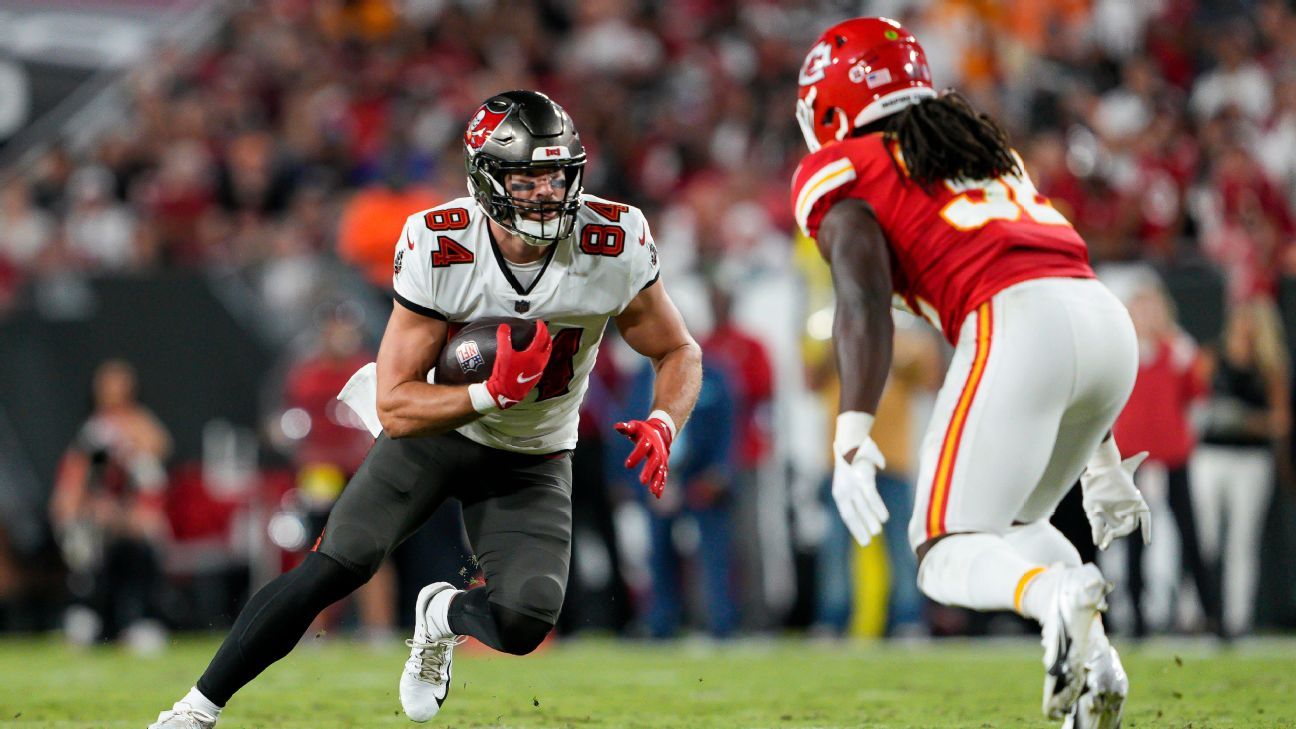TAMPA, Fla. — The Tampa Bay Buccaneers‘ handling of Cameron Brate‘s concussion against the Kansas City Chiefs on Sunday night raised some eyebrows, but coach Todd Bowles said Monday that the team initially believed the tight end injured a shoulder and did not show concussion symptoms until halftime, which is why he remained in the game.
With 1 minute, 35 seconds to go in the second quarter, Brate’s head collided with teammate Chris Godwin‘s shoulder as he was running across the field. Brate flung backward onto the ground, drawing a collective gasp from the crowd.
“He went on the sideline. He complained of shoulder discomfort, nothing about his head,” Bowles said Monday. “He was checked out three times. You just say, ‘Give him a minute.’ Nothing came up. He went back in until the end of the half. At halftime, he started having symptoms, but they were delayed. He started complaining about that. We tested him, he’s in the protocol, and we kept him out the rest of the game.”
Brate lay on the field for a few seconds, appearing dazed, and was slow to get up. Offensive tackle Tristan Wirfs put an arm around him. Then as he jogged off the field before the next play, Brate ran into an official. It is unclear what caused him to run into the official — the fact that he was trying to get off the field quickly or that he was disoriented, and Brate was not available after the game to answer questions about it, as players with concussions are not permitted to speak to the media.
After he went to the sideline, Brate did not go into the medical tent to be examined and was back on the field for that same series. He suffered no obvious additional blows to the head after that play, but he was ruled out with a concussion in the third quarter.
When asked why no one tested Brate for a concussion given the violent nature of the hit, Bowles explained, “He complained about his shoulder, not his head. You can’t see a neurologist or talk about concussions if you only complained about the shoulder. It came up at halftime where he started to have symptoms about his head. So when you say, ‘Your shoulder’s hurting, you need a second for your shoulder.’ Nobody’s really checking off your head. And then you go back in, you find out at halftime that you have symptoms in your head, then you go, ‘Concussion, concussion protocol.’ That’s all you can do, really.”
Former Bucs head coach and Pro Football Hall of Famer Tony Dungy, who was on the sideline working as an analyst for NBC Sports, was critical of Brate going back into the game and called the NFL’s concussion protocol a “broken system.” He also expressed concern as to why play wasn’t stopped by the officials.
The league’s handling of concussions has come under extreme scrutiny in the past week. The NFL and NFL Players Association launched an investigation into the Miami Dolphins‘ handling of quarterback Tua Tagovailoa, who showed significant signs of neurological impairment — stumbling to the ground after taking a hit from Buffalo Bills linebacker Matt Milano — in Week 3.
Tagovailoa was cleared to reenter the game by an independent neurologist, and he was cleared to play just four days later, when he was hit again, by Cincinnati Bengals defensive tackle Josh Tupou on Thursday Night Football, and appeared to exhibit what’s called a “fencing response,” which involves locking the fingers and arms into an unusual position after a blow to the head impacts the brainstem. He left the game on a stretcher. The independent neurologist who cleared Tagovailoa to play was fired for the NFLPA on Saturday. Tagovailoa is in the concussion protocol and has already been ruled out this week.
In Brate’s case, the Bucs relied on him speaking up about his symptoms, and it might shed light on a layer of the concussion protocol that needs to be reexamined, in which the responsibility shifts from players self-reporting to those charged with the task of monitoring them, which, in this case, would be the coaches, training staff and independent neurologists.
The NFL and NFLPA are working on revising the protocol, including language that would prohibit a player from reentering a game if the player showed gross motor instability (a current loophole that exists is if the player and team say the instability was caused by another injury; in Tagovailoa’s case, it was his back). In the meantime, team trainers and independent neurologists were encouraged to err on the side of caution this week.
“It’s always important for players to speak up,” Bowles said. “It’s important for us to see it as well. Obviously, we see a hard hit, somebody upside the head, you want to take a look at it. Some things you don’t see as it’s anywhere around this area right here (points to the collarbone area) that may have delayed reaction with a knee-jerk thing. So player safety’s important for us in this league. We’re not trying to play anybody that’s hurt.”
